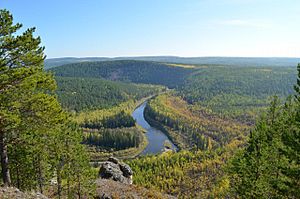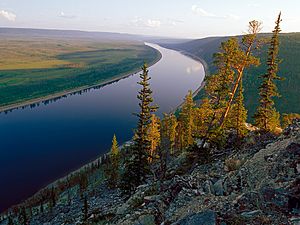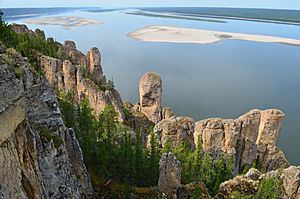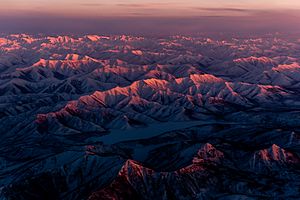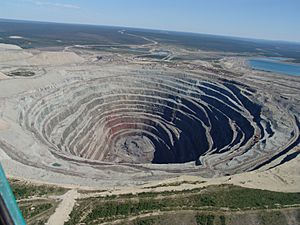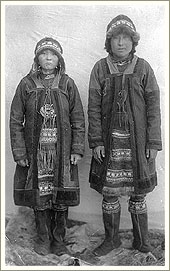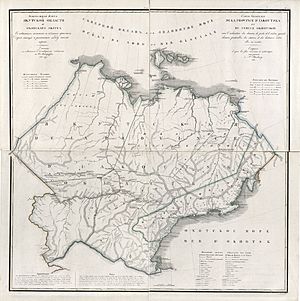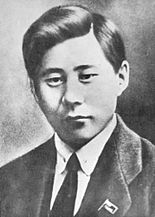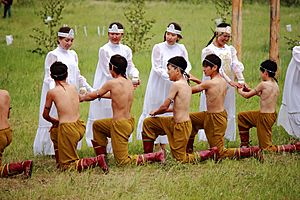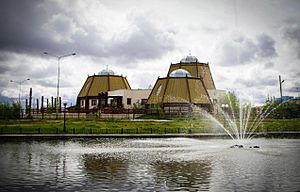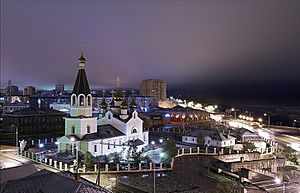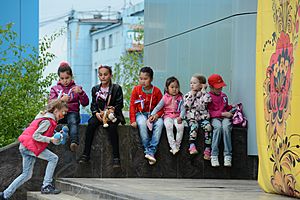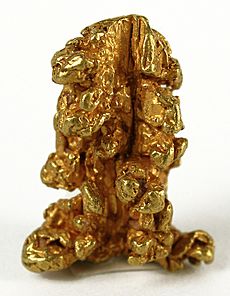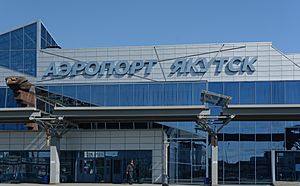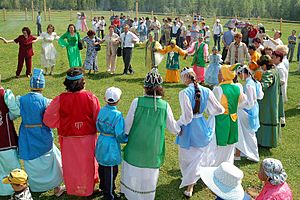Sakha facts for kids
Quick facts for kids Republic of Sakha (Yakutia)Республика Саха (Якутия) (Russian) Саха Өрөспүүбүлүкэтэ (Yakut) Saxa Öröspüübülükete (Romanization) |
|||||
|---|---|---|---|---|---|
| — Republic — | |||||
|
|||||
|
|
|||||
|
|||||
| Political status | |||||
| Country | Russia | ||||
| Federal district | Far Eastern | ||||
| Economic region | Far Eastern | ||||
| Established | April 27, 1922 | ||||
| Capital | Yakutsk | ||||
| Government (as of May 2018) | |||||
| • Head | Aysen Nikolayev | ||||
| • Legislature | State Assembly (Il Tumen) | ||||
| Statistics | |||||
| Area (as of the 2002 Census) | |||||
| • Total | 3,083,523 km2 (1,190,555 sq mi) | ||||
| Area rank | 1st | ||||
| ISO 3166-2 | RU-SA | ||||
| License plates | 14 | ||||
| Official languages | Russian; Yakut | ||||
Sakha, also known as the Republic of Sakha (Yakutia), is the largest republic in Russia. It is located in the Russian Far East, next to the Arctic Ocean. About one million people live here. Sakha covers a huge area of over 3 million square kilometers (1.19 million sq mi). This makes it the largest country subdivision in the world.
Yakutsk is the capital and largest city. It is known as the world's coldest major city. Sakha has a very extreme climate. Some of the lowest temperatures in the Northern Hemisphere have been recorded in places like Verkhoyansk and Oymyakon. Winter temperatures in Yakutsk often drop below -35°C (-31°F). However, summers can be quite warm in many parts of the republic.
Long ago, the area was home to hunting-gathering people like the Evenks and Yukaghir. Later, the Sakha people (also called Yakuts) moved here from near Lake Baikal. They arrived between the 9th and 16th centuries, bringing their way of life based on raising animals.
The Russians came in the 1600s and made the area part of Tsardom of Russia. They called it Yakutsk Oblast. The local people had to pay a fur tax. Over time, more Russians moved to the area. In 1922, it became the autonomous Yakut ASSR. On December 27, 1991, it was officially named the "Republic of Sakha (Yakutia)".
Contents
What's in a Name?
The name Yakut was given by the Evenks, a neighboring group. The Russians then started using this name. Other nearby people, the Yukaghirs, also used similar names.
The people of Sakha call themselves Sakha. This name likely comes from the same origin as the name Yakut. The Dolgans, who speak a language similar to Sakha, pronounce it as Haka.
Exploring Sakha's Geography

Sakha is a very large region with many different landscapes.
Borders and Neighbors
Sakha shares land borders with several other parts of Russia:
- To the east and northeast: Chukotka Autonomous Okrug
- To the east: Magadan Oblast
- To the southeast: Khabarovsk Krai
- To the south: Amur Oblast, Zabaykalsky Krai, Irkutsk Oblast
- To the west: Krasnoyarsk Krai
Its northern side is bordered by the Arctic Ocean. This includes the Laptev Sea and the Eastern Siberian Sea. These waters are very cold and covered in ice for most of the year. The New Siberian Islands are also part of Sakha.
Highest Points and Size
The highest point in Sakha is Peak Pobeda, which is 3,003 meters (9,852 feet) tall. Another high peak is Mus-Khaya Mountain at 2,959 meters (9,708 feet).
Sakha stretches about 2,500 kilometers (1,550 miles) from north to south. It is about 2,000 kilometers (1,240 miles) from east to west. Its total area is 3,083,523 square kilometers (1,190,555 sq mi). This makes it slightly smaller than India.
Nature and Plants
Sakha has three main types of plant life. About 40% of Sakha is above the Arctic circle. This entire area has permafrost, which is ground that stays frozen all year. Permafrost affects the environment and limits where forests can grow.
In the middle region, you find Arctic and subarctic tundra. Here, lichen and moss grow like green carpets. This is a favorite place for reindeer to graze. Further south in the tundra, you can see small Siberian pine and larch trees along rivers.
Below the tundra is the huge taiga forest. Larch trees are common in the north. In the south, you start to see fir and pine trees. Taiga forests cover about 47% of Sakha. Most of these trees are larch.
There's a special project called Pleistocene Park in Sakha. It aims to bring back the ancient grasslands of the Ice Age. They do this by bringing in animals that lived there long ago.
Time Zones in Sakha
Sakha is the only part of Russia that uses more than one time zone. It spans three different time zones. Russia does not use daylight saving time.
| Map | Time zone | Abbr. | UTC offset | Areas |
|---|---|---|---|---|
| Yakutsk Time | YAKT | UTC+09:00 | Most of the republic's territory | |
| Vladivostok Time | VLAT | UTC+10:00 | Districts of Oymyakonsky, Ust-Yansky and Verkhoyansky | |
| Magadan Time | MAGT | UTC+11:00 | Districts of Abyysky, Allaikhovsky, Momsky, Nizhnekolymsky, Srednekolymsky and Verkhnekolymsky |
Rivers of Sakha
The biggest river in Sakha is the Lena River, which is 4,400 kilometers (2,734 miles) long. It is used for boats and ships. Many smaller rivers flow into the Lena River.
- Lena River
- Vilyuy River (2,650 km)
- Markha River (1,181 km)
- Morkoka River (812 km)
- Tyung River (1,092 km)
- Markha River (1,181 km)
- Aldan River (2,273 km)
- Amga River (1,462 km)
- Maya River (1,053 km)
- Uchur River (812 km)
- Olyokma River (1,320 km)
- Linde River (804 km)
- Nyuya River (798 km)
- Vilyuy River (2,650 km)
- Olenyok River (2,292 km)
- Kolyma River (2,129 km)
- Indigirka River (1,726 km)
- Selennyakh River (796 km)
- Alazeya River (1,590 km)
- Anabar River (939 km)
- Yana River (872 km)
- Adycha River (715 km)
- Oldzho River (330 km)
- Bytantay River (620 km)
Lakes of Sakha
Sakha has more than 800,000 lakes! Some of the major lakes and reservoirs are:
- Lake Bolshoye Morskoye
- Lake Bustakh
- Emanda
- Lake Mogotoyevo
- Nedzheli
- Lake Nerpichye
- Lake Ozhogino
- Lake Suturuokha
- Tabanda
- Ulakhan-Kyuel
- Vilyuy Reservoir
Mountains of Sakha
The biggest mountain range in Sakha is the Verkhoyansk Range. It runs next to the Lena River. The Chersky Range is east of the Verkhoyansk Range. It has the highest peak in Sakha, Peak Pobeda. The Stanovoy Range is along Sakha's southern border.
Peninsulas of Sakha
Sakha has a long coastline with many peninsulas. Some of the important ones are:
- Uryung-Tumus Peninsula
- Nordvik Peninsula
- Terpyay-Tumsa Peninsula
- Bykovsky Peninsula
- Buor-Khaya Peninsula
- Manyko Peninsula
- Shirokostan Peninsula
- Merkushina Strelka Peninsula
- Lopatka Peninsula
- Dogukan Peninsula
Islands of Sakha
Here are some of the main islands that belong to Sakha:
- Preobrazheniya Island
- Bolshoy Begichev Island
- Maliy Begichev Island
- Peschany Island
- Salkay Island
- Orto Ary
- Daldalakh
- Dyangylakh Island
- Dunay Islands
- Leykina Island
- Islands of the Lena Delta
- Brusneva Island
- Muostakh Island
- Ulakhan Ary Island
- Yarok Island
- Shelonsky Islands
- Makar Island
- Stolbovoy Island
- New Siberian Islands (the largest group)
- De Long Islands
- Medvezhyi Islands
- Kolesovsky Island
- Kolesovskaya Otmel
- Gabyshevskiy Island
- Kamenka Island
- Markhayanovskiy Island
- Gusmp Island
- Sukhanyy Island
Natural Resources
Sakha has many natural resources. Its ground holds large amounts of oil, gas, coal, diamonds, gold, silver, tin, and tungsten. Sakha produces 99% of all diamonds in Russia. It also produces over 25% of the world's diamonds.
Climate Extremes
Sakha is famous for its extreme weather. The Verkhoyansk Range is the coldest area in the Northern Hemisphere. Some of the lowest natural temperatures ever recorded have been here. The Northern Hemisphere's Pole of Cold is in Verkhoyansk, where temperatures dropped to -67.8°C (-90°F) in 1892. In Oymyakon, temperatures reached -71.2°C (-96.2°F) in January 1924.
| City | July (°C) | July (°F) | January (°C) | January (°F) |
|---|---|---|---|---|
| Aldan | 22.6/10.9 | 72.7/51.6 | −21.9/−30.6 | −7.4/−23.1 |
| Neryungri | 21.8/10.9 | 71.24/51.62 | −26.8/−33.9 | −16.24/−29.02 |
| Olyokminsk | 24.9/12 | 76.8/53.6 | −26.2/−34.6 | −15.2/−30.28 |
| Oymyakon | 22.7/6.1 | 72.9/43 | −42.5/−50 | −44.5/−58 |
| Verkhoyansk | 23.5/9.7 | 74.3/49.5 | −42.4/−48.3 | −44.3/−54.9 |
| Yakutsk | 25.5/12.7 | 78/54.9 | −35.1/−41.5 | −31.2/−42.7 |
| Saskylakh | 16.8/7.7 | 62.2/45.9 | −29.2/−36.7 | −20.6/−34.1 |
| Tiksi | 12.1/3.9 | 53.8/39 | −26.7/−33.8 | −16.1/−28.8 |
The average yearly rainfall is between 200 mm (in central parts) and 700 mm (in the eastern mountains).
History of Sakha
Ancient Times
Sakha is important for finding ancient animal remains. Many prehistoric animals from the Ice Age are preserved in the ice or permafrost. In 2015, frozen bodies of cave lion cubs were found. Also, woolly mammoths, a woolly rhinoceros, bison, and horses have been discovered. In 2019, the preserved head of a large wolf from over 40,000 years ago was found.
The Ymyakhtakh culture existed around 2200–1300 BC. It was a Late Neolithic culture that started in the Lena River basin in Sakha. From there, it spread to other areas.
Early Settlements
The Sakha people (Yakuts) are a Turkic group. They may have settled in the area as early as the 9th century or as late as the 16th century. They moved north from the Lake Baikal region to the middle Lena River. They brought their way of life, which involved raising animals.
The Sakha people replaced smaller groups who lived by hunting and herding reindeer. By the 17th century, most of the original people had joined the Sakha culture.
Russian Arrival
The Tsardom of Russia began to take control of the region in the 17th century. Tygyn Darkhan, a leader of the Khangalassky Sakha, allowed Russians to settle. He did this in exchange for military help against other local groups.
In 1638, the Moscow Government created a new area called Lensky Ostrog. This later became the city of Yakutsk, which was founded in 1632.
Russian settlers also arrived at Russkoye Ustye in the 17th century. In 1708, the Siberian Governorate was created as part of the Russian Empire.
By the 18th century, Russian settlers formed their own community. They adopted some Sakha customs. However, later settlers mostly became part of the Russian mainstream.
Under the Russian Empire
In 1782, the Irkutsk Governorate was formed. In 1805, Yakutsk Oblast was separated from it.
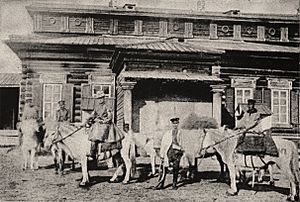
In the early 1800s, Yakutsk Oblast was the easternmost part of the Russian Empire. Later, in 1856, the Pacific territories were separated from Sakha.
Russians started farming in the Lena River basin. People exiled to Sakha in the late 1800s began to grow wheat, oats, and potatoes. The fur trade helped create a money-based economy. Industries and transportation started to grow in the late 1800s and early 1900s. This included searching for minerals, mining, and making lead. The first steam-powered ships arrived.
Sakha was a popular place for both Tsarist and Communist governments to send exiles. Famous exiles included the writer Nikolay Chernyshevsky and the Polish activist Wacław Sieroszewski.
A Sakha national movement began during the 1905 Revolution. They wanted more say in their government. Their demand for a Sakha representative in the Duma was eventually granted.
Soviet Era Changes
Sakha was the site of some of the last battles of the Russian Civil War. On April 27, 1922, the Yakutsk Oblast became the Yakut ASSR.
During the early Soviet period, Sakha literature grew. Writers like Platon Oyunsky wrote down the traditional oral stories called olonkho. Many early Sakha leaders died during the Great Purge.
Many ethnic Russians and Ukrainians moved to Sakha during the Soviet period. They mostly settled in Yakutsk and the industrial south. This changed the population makeup of the region.
After the Soviet Union
In 1992, after the fall of the Soviet Union, Sakha became the Sakha (Yakutia) Republic. It is part of the Russian Federation. Soldiers from Sakha have been involved in recent conflicts.
Population and People
Population: In 2021, Sakha had 995,686 people. The population density is very low, with only about 0.31 people per square kilometer. Most people (65.45%) live in cities.
Major Cities and Towns
|
Largest cities or towns in the Sakha Republic
2021 Russian Census |
||
|---|---|---|
| Rank | Pop. | |
| 1 | Yakutsk | 355,443 |
| 2 | Neryungri | 53,409 |
| 3 | Mirny | 34,045 |
| 4 | Aldan | 21,590 |
| 5 | Lensk | 21,392 |
| 6 | Aykhal | 13,370 |
| 7 | Udachny | 12,930 |
| 8 | Suntar | 10,302 |
| 9 | Nyurba | 10,138 |
| 10 | Vilyuysk | 10,032 |
Ethnic Groups in Sakha
According to the 2021 Census, the main ethnic groups are:
- Sakha: 55.3%
- Russians: 32.6%
- Evenks: 2.9%
- Evens: 1.6%
- Kyrgyz: 1.3%
- Ukrainians: 0.8%
- Buryats: 0.8%
- Tajiks: 0.7%
Languages Spoken
The official languages are Russian and Sakha (also called Yakut). About half of the people in the republic speak Sakha. In 2021, 95% of Yakuts, 72% of Evenks, and 60% of Evens said Sakha was their native language. The Sakha language is part of the Turkic languages family. It is similar to the Dolgan language.
Many people in Sakha also speak Tungusic languages, like Evenki and Even. In the northeast, people speak Chukchi and Yukaghir languages.
| Ethnicity | Native language | ||
|---|---|---|---|
| Russian | Sakha | Other | |
| Russians | 99.4% | 0.4% | 0.2% |
| Yakuts | 5.0% | 95.0% | 0.0% |
| Evenks | 12.3% | 72.4% | 15.3% |
| Evens | 10.7% | 60.2% | 29.1% |
Religions and Beliefs
| Religion in Sakha Republic as of 2012 (Sreda Arena Atlas) | ||||
|---|---|---|---|---|
| Russian Orthodoxy | 37.8% | |||
| Protestantism | 0.8% | |||
| Other Christians | 0.8% | |||
| Islam | 2% | |||
| Tengrism and other native faiths | 13% | |||
| Spiritual but not religious | 16.6% | |||
| Atheism and irreligion | 25.6% | |||
| Other and undeclared | 4% | |||
Before the Russians arrived, most local people followed Tengrism or shamanism. These were traditional beliefs of Turkic and Paleoasian peoples. When Russians came, many people became part of the Russian Orthodox Church. However, they often continued to practice their traditional religions alongside.
In the 1990s, a new shamanist movement called aiyy yeurekhé started. This group helped build a shaman temple in Yakutsk in 2002.
Today, many people still follow Orthodox Christianity. But there is also a lot of interest in bringing back traditional religions. People sometimes combine different beliefs.
A 2012 survey showed that 37.8% of people in Sakha follow the Russian Orthodox Church. 13% follow Tengrism or Sakha shamanism. Other religions include Islam, Protestantism, and Tibetan Buddhism. Many people also say they are atheist or "spiritual but not religious."
Education in Sakha
Important places for higher education include North-Eastern Federal University (formerly Yakutsk State University) and Yakutsk State Agricultural Academy.
Government and Politics
The leader of Sakha's government is called the Head. The current Head is Aysen Nikolayev, who started his role in 2018.
The main law-making body in Sakha is the State Assembly, also known as the Il Tumen. The government of Sakha (Yakutia) Republic is in charge of carrying out laws.
Sakha works closely with other Turkic countries. It is part of groups like the Turkic Council. There are some people in Sakha who want to create an independent Yakutian state. They believe the federal government uses their resources unfairly.
Economy and Resources
Industry makes up over 50% of Sakha's economy. This mostly comes from mining. Factories are found in cities like Yakutsk, Aldan, Mirny, Neryungri, Pokrovsk, and Udachny. The main industries are mining for diamonds, gold, and tin. Uranium mining is also starting.
The Sakha people are involved in politics, government, and finance. They also raise animals like horses and cows for milk and meat. The original peoples of the area are hunters, fishermen, and reindeer herders.
The biggest companies in the region include Alrosa (diamonds), Yakutugol (coal), Yakutskenergo (energy), and Yakutia Airlines.
Transportation in Sakha
Water transport is very important for moving goods. There are six river ports and two seaports (Tiksi and Zelyony Mys). The main waterway is the Lena River. It connects Yakutsk to the train station in Ust-Kut.
Air travel is the most important way for people to get around. Airlines connect Sakha with most parts of Russia. Yakutsk Airport also has international flights.
Two main federal roads cross the republic: the Yakutsk–Skovorodino highway (A360 Lena highway) and the Yakutsk–Magadan highway (M56 Kolyma Highway). Because of the permafrost, these roads are often made of clay instead of asphalt. Heavy rains can turn them into mud, sometimes trapping travelers.
The Berkakit–Tommot railroad is open. It links the Baikal-Amur Mainline to industrial areas in South Sakha. The Amur–Yakutsk Mainline railway is still being built northwards. It reached Nizhny Bestyakh in 2013.
Media and Entertainment
NVK Sakha is the largest media company in the Republic of Sakha (Yakutia). It owns many TV channels in Yakutia, Russia, and other countries. They broadcast in Yakut, English, Russian, and Evenk. The company started in 1992. NVK Sakha also has its own studios for animation, films, and music. Since 2018, they have been streaming online 24/7.
Culture and Arts
In the city of Yakutsk, you can find several interesting places:
- The State Russian drama theatre named after Alexander Pushkin
- The Sakha Theater named after Platon Oyunsky
- The State Academic Opera and Ballet Theatre named after D. K. Sivtsev
- Suorun Omoloon, the Young Spectator's Theatre
There are also many museums. These include the National Fine Arts Museum of Sakha, the Museum of Local Lore and History, and the Khomus Museum. In 2020, the Gagarin Center for Culture and Contemporary Art opened in Yakutsk.
In the 2010s, the film industry in Yakutia became very popular. It was even called "Sakhawood."
Special Days
- April 27: Republic Day
- June 21: Yhyakh festival (also known as Sakha New Year)
See also
 In Spanish: Sajá para niños
In Spanish: Sajá para niños
- Cuisine of Sakha
- Lena Pillars
- List of rural localities in the Sakha Republic
- Music in the Sakha Republic
- Tuymaada
- Yakutian knife
- Yakut language
Images for kids






